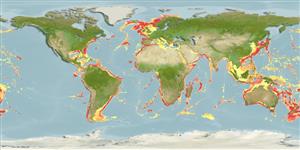Preferred temperature (Ref.
115969): 2.5 - 14.3, mean 5.3 (based on 3093 cells).
Phylogenetic diversity index (Ref.
82804): PD
50 = 1.0020 [Uniqueness, from 0.5 = low to 2.0 = high].
Bayesian length-weight: a=0.00372 (0.00141 - 0.00976), b=3.12 (2.89 - 3.35), in cm Total Length, based on LWR estimates for this (Sub)family-body shape (Ref.
93245).
Nivel trófico (Ref.
69278): 4.2 ±0.4 se; based on diet studies.
Resiliencia (Ref.
120179): Bajo, población duplicada en un tiempo mínimo de 4.5-14 años (Fec=10-20).
Prior r = 0.27, 95% CL = 0.18 - 0.40, Based on 1 data-limited stock assessment.
Fishing Vulnerability (Ref.
59153): High to very high vulnerability (65 of 100).
Climate Vulnerability (Ref.
125649): Moderate vulnerability (38 of 100).
